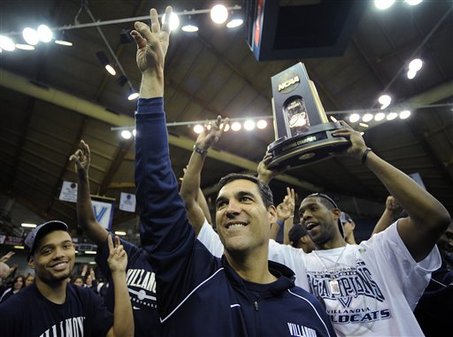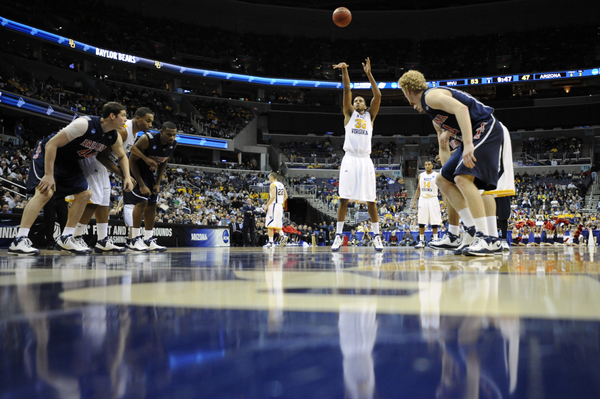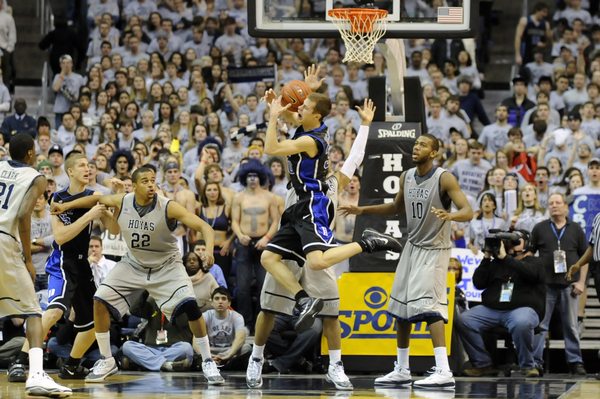
Rob Dauster of Ballin is a Habit is the RTC correspondent for the Big East Conference.
Here we are on the brink of Big East play. What does that mean? MID-SEASON AWARD TIME!!!
Co-Players of the Year: Da’Sean Butler, West Virginia and Wes Johnson, Syracuse
Depending on who you ask, these two are in the mix for the national player of the year. Butler (16.5 ppg, 6.0 rpg, 3.8 apg) has been the best player for West Virginia, even sliding over and playing some point guard in the past few games as Joe Mazzulla works his way back from a shoulder injury and Truck Bryant battles ankle and groin injuries. Butler may not be West Virginia’s best NBA prospect, but he has been the Mountaineers’ most valuable player this season. He is their best scorer in the halfcourt, and is quick becoming their best creator. He can step outside and knock down a three or run the point just as well as he can post up a smaller defender. He’s also hit two game-winners in the last two weeks.
Johnson has really lived up to the excessive hype he had in the preseason. He is averaging 17.0 ppg, 9.0 rpg, 2.3 spg, and 2.0 bpg while shooting 51.1% from three. His length, athleticism and versatility has been his biggest assets; he makes it so difficult for opposing players on the baseline in the Cuse zone; he plays like a three on the offensive end, but blocks shots and rebounds like a four on the defensive end; and most importantly, he can really score, be it in transition or in the half court set. Think the love child of T-Mac and Shawn Marion. Scary, right?
Freshman of the Year: Lance Stephenson, Cincinnati
Born Ready wasn’t quite born ready, but 11 games into the season, its pretty clear that Stephenson is going to be a player in this league. Stephenson has averaged 12.5 ppg and 2.4 apg, but more than the numbers he has put up, it has been what he hasn’t done that has been most important – this kid is not a distraction. Yes, he does have his outbursts (his reaction at the end of the Gonzaga game and his yapping at Chris Mack in the Xavier game come to mind), but what 19 year old doesn’t? Cincy has struggled a bit early in the season as they haven’t quite lived up to some of the lofty expectations, but none of that has been Lance’s fault. He makes smart plays, he makes unselfish plays, and, most importantly, he simply makes plays.
All-Conference Teams
1st team
- Luke Harangody, Notre Dame: 24.2 ppg, 9.9 rpg
- Jerome Dyson, UConn: 19.8 ppg, 5.3 rpg, 4.7 apg
- Lazar Hayward, Marquette: 19.1 ppg, 6.8 rpg
- Dominique Jones, South Florida: 18.6 ppg, 5.8 apg, 4.8 rpg, 2.2 spg
- Kevin Jones, West Virginia: 15.1 ppg, 7.6 rpg
2nd team
- Jeremy Hazell, Seton Hall: 23.3 ppg, 4.3 rpg, 2.2 spg
- Stanley Robinson, UConn: 17.0 ppg, 7.4 rpg
- Scottie Reynolds, Villanova: 17.2 ppg, 4.2 rpg, 3.5 apg
- DJ Kennedy, St. John’s: 16.6 ppg, 6.3 rpg
- Greg Monroe, Georgetown: 15.3 ppg, 10.5 rpg, 3.0 apg
3rd team
- Andy Rautins, Syracuse: 9.5 ppg, 5.2 apg, 2.5 spg
- Herb Pope, Seton Hall: 13.8 ppg, 12.4 rpg, 2.4 bpg
- Samardo Samuels, Louisville: 16.8 ppg, 7.6 rpg
- Antonio Pena, Villanova: 13.1 ppg, 8.9 rpg
- Gus Gilchrist, South Florida: 18.8 ppg, 7.4 rpg
Biggest Surprise – team: Syracuse
If I have to explain this to you, you should be reading Perez Hilton and not Rush the Court.
Biggest Surprises – player: Kevin Jones, West Virginia and Tim Abromaitis, Notre Dame
We knew that Jones was good. He’s long, he’s strong, he’s athletic, and he has a nose for the ball, which makes him a perfect fit for a Bob Huggins-coached team. But did anyone expect him to be West Virginia’s best low post player? He has given the Mountaineers a true low-post threat, he can knock down threes, and he attacks the offensive glass very hard. 15.1 ppg and 7.6 rpg is just the beginning for this kid.
Tim Abromaitis is a different story. He barely played as a freshman and redshirted last year, and when Scott Martin went down with an ACL injury in the preseason, a chance was given and Abro has made the most of it. He is averaging 15.8 ppg while shooting 50.7% from three, giving Notre Dame another option if defenses collapse on Harangody. If he can bulk up a bit and become a better rebounder, Abro may be an all-conference player when it is all said and done.
Biggest Disappointment – team and player: Deonta Vaughn, Cincinnati
I really thought that the Bearcats were going to make a push for the Big East crown this season. With Vaughn teaming up with Stephenson and Cashmere Wright on the perimeter and Yancy Gates anchoring a big, physical front line, I thought this team had the roster to be a factor. But with Vaughn’s early season struggles, Cincy has lost three games in the non-conference, and has yet to look like a contender. For the first time in his career, Vaughn is averaging below double figures at just 9.8 ppg, but lets face it – he is just too talented to struggle for a full season. I’m not writing off the Bearcats just yet.
The runner-up for most disappointing team is Seton Hall. The Pirates have a ton of talent, but they just don’t have the team chemistry to compete with the big dogs. I’m not talking about the players getting along. They may very well be best friends. What I mean is that this team just doesn’t play well together right now. Jeremy Hazell, as good as he is, seems to be more concerned with finding his best shot of offense as opposed to the team’s best shot. Herb Pope is a load on the block, but he can’t hit free throws, turns the ball over too much, and seems lost offensively at times. Eugene Harvey, Keon Lawrence, Robert Mitchell, Jeff Robinson – these guys over-dribble and don’t consistently take good shots. Seton Hall could easily be 2-0 in the league right now, but instead they have dropped two heartbreakers early on, and in a league as balanced as the Big East is, that is going to be a tough thing to overcome.
Coach of the Year: Norm Roberts, St. John’s
The Johnnies are flirting with the bubble this season, and with a good performance in the Big East, the Red Storm could very well make it back to the tournament this season. And keep in mind that St. John’s has done this without Anthony Mason, Jr., playing a minute yet this season and with Justin Burrell missing a few weeks with an ankle injury.
Notes
- West Virginia is currently playing with five forwards in their starting line-up – Butler, Jones, Ebanks, Wellington Smith and John Flowers – as Truck Bryant battles ankle and groin injuries and Joe Mazzulla makes his way back from a shoulder injury. This creates two problems for the Mountaineers – they are struggling against pressure defenses and creating easy shots in the halfcourt, and they give up way too much penetration. This was completely evident against Marquette, as the Golden Eagles spread the floor, attacked gaps, and got a number of wide-open looks from three. But this is a good thing for WVU, believe it or not. Mazzulla is not going to be healthy this season (he’s playing right now with the inability to raise his left arm – he’s shooting free throws right handed as a lefty), which means that once Bryant gets healthy, they will have one true point guard. If injuries our foul trouble strikes later in the season, learning to play with five forwards now is better than learning in March.
- UConn has two major achilles heels this season – depth and free throw shooting. The addition of Ater Majok is not going to be as influential as many believe. Majok is long and plays with energy, but he has no basketball IQ and he is nothing more than length right now – he’ll block a few shots and grab a few boards, but he’s a 12-15 mpg player at best. Jamal Coombs-McDaniel has played well in the last couple of games, but he is still learning what it takes to compete in the Big East. This is still basically a five player team. But the bigger issue will be free throw shooting. Neither Stanley Robinson nor Jerome Dyson are great free throw shooters, which is a big problem when you consider how often these two are going to get to the line the way they attack the rim. UConn is going to struggle to put points on the board, and a few missed free throws are going to make a huge difference. You can argue pretty convincingly that it cost them both the Duke and Kentucky games.
- Villanova is not going to be a great team until they play better defense. KenPom has them at 89th in the country right now in tempo-free defensive efficiency. They give up too much penetration, allow too many open threes, and don’t have the size inside to prevent post-ups and defend at the rim. This team is really going to miss Dwayne Anderson and Shane Clark, but hopefully getting Reggie Redding back will make a difference.
- Jeremy Hazell scored 41 and 38 points in losses to West Virginia and Syracuse, respectively, but it took him 64 shots to do so. He needs to be more efficient and/or take better shots for the Pirates. Any above average guard in this league could put up those numbers with that many shots.
- Chris Wright had 34 points in Georgetown’s win over Harvard, but lost in that was the fact that he still had 4 turnovers and just 4 assists. On the season, he is only averaging 3.5 apg and 3.0 turnovers.
Power Rankings
1. Syracuse – 13-0, 1-0
Last Week: 12/29 @ Seton Hall 80-73
Next Week: 1/2 vs. Pitt
2. West Virginia – 10-0, 2-0
Last Week: 12/26 @ Seton Hall 90-84, 12/29 vs. Marquette 63-62
Next Week: 1/1 @ Purdue
3. Villanova – 11-1
Last Week: 12/23 vs. Delaware 97-63
Next Week: 1/2 @ Marquette
4. Georgetown – 9-1
Last Week: 12/23 vs. Harvard
Next Week: 1/3 @ DePaul
5. UConn – 9-2
Last Week: 12/27 vs. Iona 93-74
Next Week: 12/30 @ Cincy 69-71, 1/2 vs. Notre Dame
6. Louisville – 9-3
Last Week: 12/23 vs. Louisiana-Lafayette 84-69, 12/27 vs. Radford 79-53
Next Week: 12/30 vs. South Florida 73-52, 1/2 @ Kentucky
7. Cincinnati – 8-3
Last Week: none
Next Week: 12/30 vs. UConn 71-69, 1/2 @ Rutgers, 1/4 vs. Pitt
8. St. John’s – 10-2
Last Week: 12/23 vs. Bryant 80-44
Next Week: 12/31 @ Georgetown, 1/3 vs. Providence
9. Marquette – 9-4, 0-1
Last Week: 12/27 vs. Presbyterian 102-62, 12/29 @ Marquette 62-63
Next Week: 1/2 vs. Villanova
10. Notre Dame – 10-2
Last Week: none
Next Week: 12/30 vs. Providence 93-78, 1/2 @ UConn, 1/6 @ South Florida
11. South Florida – 10-2
Last Week: none
Next Week: 12/30 @ Louisville 52-73, 1/5 vs. Notre Dame
12. Seton Hall – 8-3, 0-2
Last Week: 12/26 vs. West Virginia 84-90, 12/29 vs. Syracuse 73-80
Next Week: 1/2 @ Virginia Tech
13. Pitt – 11-2, 1-0
Last Week: 12/28 vs. DePaul 65-52
Next Week: 1/2 @ Syracuse, 1/4 @ Cincinnati
14. Rutgers – 9-3
Last Week: 12/28 @ UNC 67-81
Next Week: 1/2 vs. Cincinnati
15. Providence – 8-4
Last Week: none
Next Week: 12/30 @ Notre Dame 78-93, 1/3 @ St. John’s
16. DePaul – 7-6, 0-1
Last Week: 12/28 @ Pitt
Next Week: 1/3 vs. Georgetown



































![45409112722_WVU_v_Texas_A&M[1]](http://rushthecourt.net/wp-content/uploads/2010/02/45409112722_WVU_v_Texas_AM1.jpg)












